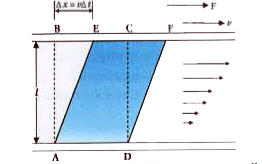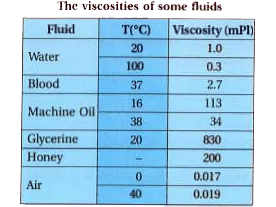Discuss coefficient of viscosity in the contex of stress and strain .Solution in Gujrati
In figure laminar flow of liquid is shown.

A layer of liquid sandwiched between two parallel glass plates in which the lower plate is fixed and the upper one is moving to the right with velocity v
Liquid layers are shown between the glass plates .
Upper plate move with velocity v hence layer contact with it also move with velocity v.
On account of this motion , a portion of liquid, which at some instant has the shape of ABCD, take the shape of AEFD after short interval of time Δt.
During time ,the liquid has undergone a shear strain of Δxl .The strain in a flowing fluid increases with time continuously.
In this case , the stress depend on the rate change of strain or stress depend on the rate change of strain or strain rate , that is ΔxlΔtorvl
instead of strain itself. (Here ΔxΔt =velocityv)
Here shearing stress is FA . Where A is the area of contact surface and F the viscous force F in the direction of tangent.
For fluid ,
coefficient of viscosity =η=Shearing stressShear strain
∴η=(F/A)(v/l)=FlvA ....(1)
OR
F=ηA(vl) ....(2)
The SI unit of viscosity is poiseiulle (Pl).
1 poiseiulle 1Nsm−2=Pa⋅s
CGS unit of coefficient of viscosity is poiseiulle
1 poiseiull =1 dyne S cm−2
1 poiseiulle =10 pois
The dimensions of viscosity are [M1L−1T−1] Generally thin liquids like water , alcohol are less viscous then thick liquids lke coal tar , blood, glycerine etc.
The viscosity of liquids decreases with temperature while it increases in the case of gases.

Topper's Solved these Questions
- MECHANICAL PROPERTIES OF FLUIDS BOOK - KUMAR PRAKASHANCHAPTER - MECHANICAL PROPERTIES OF FLUIDS EXERCISE - SECTION-A Try Yourself (VSQs)
132 Videos
- MECHANICAL PROPERTIES OF FLUIDS BOOK - KUMAR PRAKASHANCHAPTER - MECHANICAL PROPERTIES OF FLUIDS EXERCISE - SECTION - B Numericals
29 Videos
- MACHANICAL PROPERTIES OF SOLIDS BOOK - KUMAR PRAKASHANCHAPTER - MACHANICAL PROPERTIES OF SOLIDS EXERCISE - QUESTION PAPER
11 Videos
- MOTION IN A STRAIGHT LINE BOOK - KUMAR PRAKASHANCHAPTER - MOTION IN A STRAIGHT LINE EXERCISE - QUESTION PAPER
11 Videos
Similar Questions
What is fluid ?
View SolutionA 14.5 kg mass, fastened to the end of a steel wire of unstretched 1.0 m, is whirled in a vertical circle with an angular velocity of 2 rev/s at the bottom of the circle. The cross- sectional area of the wire is 0.065 cm2. Calculate the elongation of the wire when the mass is at the lowest point of its path.
View SolutionWhat is called brittle material ?
View SolutionDefine frame of reference and give its types.
View SolutionSTRESS-STRAIN DIAGRAM
View SolutionStress to strain ratio is equivalent to
View SolutionStress & Strain
View SolutionElasticity: Longitudinal Stress & strain | Shear stress & shear strain | Volumetric stress and strain
View SolutionStress And Strain|Hookes Law#!#Stress Strain Curve
View SolutionExplain hydraulic stress, volume stress and volume strain
View SolutionStress & Strain
View SolutionStress Strain Diagram
View SolutionOn gradual loading , stress - strain relationship for a metal wire is as follows . Within proportionality limit , stress prop strain or, "Stress"/"strain" = a constant for the material of wire. If "Stress"/"Strain" is x in elastic region and y in the region of yield , then
View SolutionDiscuss about stress-strain curve .
View SolutionNormal Force|| Stress and Strain
View Solution
